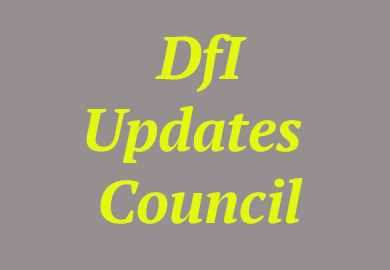Council gets update on infrastructure projects for Newry Mourne and Down District.
Newry Mourne and Down District Council members have been updated on works in the area by the Department for Infrastructure.
Speaking as he addressed council members this evening, Divisional Roads Manager Mr Simon Richardson, said: “Over the past year, a number of significant resurfacing schemes have been completed including the A26 Strangford Road, Chapeltown; A2 Seaview, Warrenpoint; Shepherds Way, Newry; Newry Road and Dundalk Road, Newtownhamilton; A37 Concession Road, Culloville: B30 Silverbridge Road, Annduff, Upper Dromore Road, Warrenpoint and Lower Foughill Road, Jonnesborough.”

Mr Richardson also advised that a number of schemes to improve the network had been undertaken including reconfiguration of traffic signals at the Bryansford Avenue/Shimna Road junction in Newcastle and changes to the road markings at the A7 Belfast Road Roundabout in Downpatrick to improve lane discipline and address collision history at this location.
These works will serve to improve both road safety and traffic progression. Other recently completed schemes include public realm works at Irish Street, Downpatrick, a Park & Ride facility at Sheepbridge with over 100 spaces and a shared footway/cycletrack and two new TOUCAN crossings linking Carnbane Road along Shepherds Way to the canal tow path in Newry.
These projects will provide widespread benefits to both the local community and enhance provision for all those walking and cycling, as well as those using roads in the Newry Mourne and Down District Council area.
Mr Richardson added: “The Department continues to face significant Resource and Capital budget challenges. Since 2013, the Department has relied on in-year funding to deliver core services including public transport and winter gritting. This continues to be the case for 2019-20. Our allocation falls well short of meeting our needs.
” It should enable the maintenance of clean drinking water supplies, however, the sewerage network is underfunded, leading to an increasing number of areas where no new connections can be accepted. Also, the continued provision of public transport services, particularly maintenance of the railway infrastructure, will be challenging.
“Similarly, the maintenance of the road network will be problematic, given its continuing deterioration and increases in raw material costs. Maintaining current levels of routine road maintenance, which were dependent on in-year funding in 2019/20, will be unlikely.
“In Capital the 2019-20 allocation to the Department represents a reduction from the previous year. Almost 70% of this budget is taken up with committed or priority projects, leaving insufficient budget to meet the Department’s responsibilities as custodian of some £40 billion of public assets; the Water and Sewerage network and the Roads and Public Transport systems.
“With the remaining funds, we will have to strike a balance between maintaining existing infrastructure in water and sewerage, the road network and public transport and new development, particularly in pursuit of the draft Programme for Government outcomes. Independent advice suggests that an investment of some £400 million per year is needed to safeguard these assets, more than double what the Department has available.
“Recent independent reports highlight that funding for roads maintenance has been below the level required for some time. Therefore, funding for structural maintenance will remain similar to last year and will again include a ‘Roads Recovery Fund’ which gives flexibility to target those roads which have been adversely impacted by recent under funding.
“While this will enable the Department to plan to deliver a reasonable programme of resurfacing schemes in the Newry Mourne & Down District Council area, funding for other programmes, such as Local Transport and Safety Measures and Street Lighting column replacement, will not be at the same level. The allocation for routine maintenance which is also similar to last year, means that we can deliver two grass cuts, a single gully clean across the network and the intervention level for potholes on lightly trafficked roads remains at 50mm,” said Mr Richardson.


























